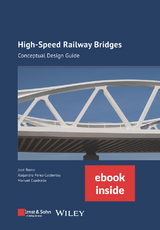High-Speed Railway Bridges
Ernst & Sohn (Verlag)
978-3-433-03381-4 (ISBN)
The editor and author José Romo and the co-authors Manuel Cuadrado and Alejandro Pérez have many years of planning experience and completed bridges for high-speed rail lines.José Romo is Chief Executive Officer and partner of FHECOR, but also a bridge engineer fully specialized in large span bridges after 39 years of experience in bridge design, 35 of them working in FHECOR. He has a huge technical knowledge based on his design background complemented with his activity as professor of concrete and steel structures in Madrid?s university, and his active participation in national and international associations of bridge designers and concrete and steel materials, he is member of many scientific committees such as Eurocodes, IABSE or ACHE where he became president in 2014 and was awarded with the honours medal in 2008. He is fellow of the Institution of Civil Engineers of UK. He has always worked as a bridge designer participating in innumerable bridge projects in Spain and worldwide, and also in the construction engineering for many of them. He has a great aesthetic vision that applies in all the designs, having at the same time a great concern for sustainability and the use of new materials and construction techniques. Manuel Cuadrado MSc in Civil engineering from the Polytechnic University of Madrid. Currently Associate Professor at the Carlos III University of Madrid and member of the Technological Committee of the Spanish Railway Research Foundation (SRRF). Manuel Cuadrado has been working for 33 years, mainly in the railway industry, for Spanish and French Engineering companies, as an independent Consultant, and from 2005 to 2017 for the SRRF. He has participated both in key Spanish High-Speed projects, and in International High-Speed Lines (Portugal, Turkey, California), and has been involved in many R&D projects mainly related to mechanical behaviour of railway infrastructures. As a result of his R&D activity he has produced many monographs, published several papers in National and International Journals and presented many papers in National and International Congresses, including WCRR 1999-Tokyo, WCRR 2001-Köln, WCRR 2006-Montreal, WCRR 2008-Seoul and WCRR 2016-Milan, and UIC High Speed Congresses 2010-Beijing and 2015-Tokio. He was also invited to participate as a specialist in the drafting of railway standards, as a member of Spanish, European and international technical committees. Finally, from December 2017, he has been participating as Infrastructure Assessor and Lead Assessor in several Rail Safety & Interoperability assessments, as Infrastructure expert and as Slab-track expert.Alejandro Pérez is full Associate Professor at the Department of Mechanics of Continuous Media and Theory of Structures for the Civil Engineering School at the Polytechnic University of Madrid. He joined FHECOR in 1989 after graduating from UPM where he also obtained his Phd in Civil Engineering in 1996. During his more than 33 years of experience, Alejandro has developed structural bridge projects in countries such as Spain, Chile, Italy or the USA. He is experienced in managing multidisciplinary structural teams, developing designs and planning and defining the scope of works. He also has extensive experience in managing and developing Research and Development projects, in Standardisation (member of the Project Team for EN 1992-1-1:2023) and in Education (Professor at UPM). He holds Engineering licenses for Spain, Chile, Virginia, Texas, Florida, North Carolina, Québec, Ontario and British Columbia. He is also a partner and member of the Board of FHECOR Consulting Engineers.
Geleitwort von Jorge Nasarre
1 Einführung zu Hochgeschwindigkeits-Eisenbahnbrücken
1.1 Zum Inhalt dieses Buches
1.2 Was ist das Besondere an einer Hochgeschwindigkeits-Eisenbahnbrücke?
1.3 Allgemeine Überlegungen
1.4 Entwicklung und Trends im HGV-Brückenbau
1.5 Die Landschaft und der Entwurf von HGV-Brücken
1.6 Eisenbahnbrücken als Wahrzeichen oder Ikonen einer Strecke
1.7 Das Erbe der Eisenbahnbrücke
1.8 Bauen für das 21. Jahrhundert
2 Gleise für Hochgeschwindigkeitsbrücken
2.1 Einleitung
2.2 Spezifische Kriterien für Eisenbahnbrücken
2.3 Spezifische Kriterien für Eisenbahnbrücken
2.4 Grenzzustand der Gebrauchstauglichkeit SLS bezogen auf das Gleis
3 Entwurf von Hochgeschwindigkeits-Eisenbahnbrücken
3.1 Einleitung
3.2 Strukturelle und funktionale spezifische Anforderungen an HSR-Brücken
3.3 Entwurfsstrategien in Längsrichtung
3.4 Entwurfssituation von Hochgeschwindigkeits-Eisenbahnbrücken
3.5 Bauwerkstypen
3.6 Strukturelemente - Unterbau
3.7 Seismischer Entwurf
3.8 Ausführungsbeispiel
4 Bemessungsgrundlagen
4.1 Einführung
4.2 Bemessungssituationen
4.3 Einwirkungen des Eisenbahnverkehrs und andere Einwirkungen speziell für Eisenbahnbrücken
4.4 Anwendung von Verkehrslasten auf Eisenbahnbrücken
4.5 Verkehrslasten bei Ermüdung
4.6 Nachweise zu Verformungen und Schwingungen für Eisenbahnbrücken
4.7 Praktisches Beispiel
5 Dynamisches Verhalten von HGV-Brücken
5.1 Einführung
5.2 Methoden für dynamische Berechnungen und Bauwerksreaktionen
5.3 Interoperabilität
5.4 Anwendungsbeispiele
6 Interaktion zwischen Fahrbahn und Bauwerk in Längsrichtung
6.1 Einleitung
6.2 Problemstellung
6.3 Modell für die Analyse
6.4 Maßnahmen
6.5 Nachweise
6.6 Schienenkompensatoren
6.7 Schemata in Längsrichtung
6.8 Beispiel für die Wechselwirkung zwischen Gleis und Bauwerk
7 Konzept für die Instandhaltung
7.1 Einführung
7.2 Zugänge
7.3 Lagerungen
7.4 Dehnungsfugen
7.5 Entwässerung
Anhang A1 Grundbegriffe der Dynamik
Anhang A2 Singuläre Brücken für Hochgeschwindigkeits-Eisenbahnstrecken
Literatur
Stichwortverzeichnis
| Erscheinungsdatum | 20.09.2023 |
|---|---|
| Verlagsort | Berlin |
| Sprache | englisch |
| Maße | 170 x 244 mm |
| Gewicht | 852 g |
| Themenwelt | Technik ► Bauwesen |
| Schlagworte | Bauingenieur- u. Bauwesen • Baustatik • Baustatik u. Baumechanik • Civil Engineering & Construction • Eisenbahnbrücke • Stahlhochbau • Stahlhochbau u. Brückenbau • Steel Construction & Bridge Engineering • Structural Theory & Structural Mechanics • Structures • Tragwerke • Transportation Engineering • Verkehrsbau |
| ISBN-10 | 3-433-03381-1 / 3433033811 |
| ISBN-13 | 978-3-433-03381-4 / 9783433033814 |
| Zustand | Neuware |
| Informationen gemäß Produktsicherheitsverordnung (GPSR) | |
| Haben Sie eine Frage zum Produkt? |
aus dem Bereich




